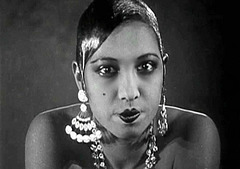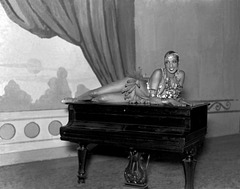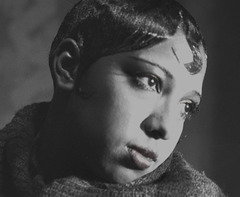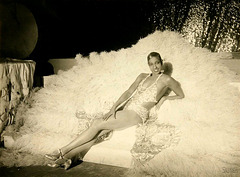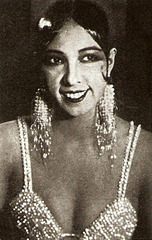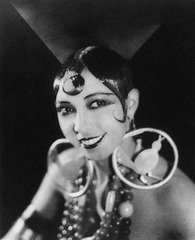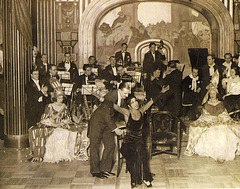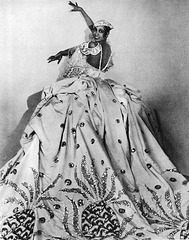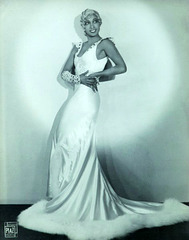
Josephine Baker
“One day I realized I was living in a country where I was afraid to be black. It was only a country for white people. Not black. So I left. I had been suffocating in the United States. A lot of us left, not because we wanted to leave, but because we couldn’t stand it anymore… I felt liberated in Paris.”
~ Josephine Baker
"America never liked Josephine Baker, above all they resented that she'd…
(read more)
Josephine Baker
| |
|
|
This was taken when Josephine performed in Finland along with her 16 piece orchestra.
Born Freda Josephine McDonald on June 3, 1906, in St. Louis, Missouri, Josephine Baker spent her youth in poverty before learning to dance and finding success on Broadway. In the 1920s she moved to France and soon became one of Europe's most popular and highest-paid performers. She worked for the French Resistance during World War II, and during the 1950s and '60s devoted herself to fighting segregation and racism in the United States. After beginning her comeback to the stage in 1973, Josephine Baker died of a cerebral hemorrhage on April 12, 1975, and was buried with military honors. [bio.com]
Josephine Baker
Josephine Baker
La Baker
Madam Baker
Josephine Baker
Josephine Baker
| |
|
The one and only Josephine Baker in her prime --- posing in her costume of bananas as she sits atop a piano at the Artigas Theater in Uruguay (photographer unknown).
She was born Freda Josephine McDonald in St. Louis, Missouri, on June 3, 1906 to washerwoman Carrie McDonald and vaudeville drummer Eddie Carson. Eddie abandoned them shortly afterward, and Carrie married a kind but perpetually unemployed man named Arthur Martin. Their family eventually grew to include a son and two more daughters.
Josephine grew up cleaning houses and babysitting for wealthy white families who reminded her “be sure not to kiss the baby.” She got a job waitressing at The Old Chauffeur’s Club when she was 13 years old. While waiting tables she met and had a brief marriage to Willie Wells. While it was unusual for a woman during her era, Josephine never depended on a man for financial support. Therefore, she never hesitated to leave when a relationship soured. She was married and divorced three more times: to American Willie Baker in 1921 (whose last name she chose to keep), Frenchman Jean Lion in 1937 (from whom she attained French citizenship), and French orchestra leader Jo Bouillon in 1947 (who helped to raise her 12 adopted children).
Josephine toured the United States with The Jones Family Band and The Dixie Steppers in 1919, performing various comical skits. When the troupes split, she tried to advance as a chorus girl for The Dixie Steppers in Sissle and Blake’s production Shuffle Along. She was rejected because she was “too skinny and too dark.” Undeterred, she learned the chorus line’s routines while working as a dresser. Thus, Josephine was the obvious replacement when a dancer left. Onstage, she rolled her eyes and purposely acted clumsy. The audience loved her comedic touch, and Josephine was a box office draw for the rest of the show’s run.
Her career thrived in the integrated Paris society; when La Revue Nègre closed, Josephine starred in La Folie du Jour at the Follies-Bergère Theater. Her jaw-dropping performance, including a costume of sixteen bananas strung into a skirt, cemented her celebrity status. Josephine rivaled Gloria Swanson and Mary Pickford as the most photographed woman in the world, and by 1927, she earned more than any entertainer in Europe. She starred in two movies in the early 1930s, Zou-Zou and Princesse Tam-Tam, and moved her family from St. Louis to Les Milandes, her estate in Castelnaud-Fayrac, France.
A 1936 return to the United States to star in the Ziegfeld Follies proved disastrous, despite the fact that she was a major celebrity in Europe. American audiences rejected the idea of a black woman with so much sophistication and power, newspaper reviews were equally cruel (The New York Times called her a “Negro Wench”), and Josephine returned to Europe heartbroken.
Josephine served France during World War II in several ways. She performed for the troops and was an honorable correspondent for the French Resistance (undercover work included smuggling secret messages written on her music sheets) and a sub-lieutenant in the Women’s Auxiliary Air Force. She was later awarded the Medal of the Resistance with Rosette and named a Chevalier of the Legion of Honor by the French government for hard work and dedication.
Josephine visited the United States during the ‘50s and ‘60s with renewed vigor to fight racism. When New York’s popular Stork Club refused her service, she engaged a head-on media battle with pro-segregation columnist Walter Winchell. The National Association for the Advancement of Colored People (NAACP) named May 20th, Josephine Baker Day in honor of her efforts.
It was also during this time that she began adopting children, forming a family she often referred to as “The Rainbow Tribe.” Josephine wanted her to prove that “children of different ethnicities and religions could still be brothers.” She often took the children with her cross-country, and when they were at Les Milandes, tours were arranged so visitors could walk the grounds and see how natural and happy the children in “The Rainbow Tribe” were.
Josephine continued to travel to the United States, and during her visits, she developed a close friendship with American artist Robert Brady. Now divorced from her fourth husband Jo Bouillon, she was looking for companionship on a more platonic level. Brady felt the same, and on a trip to Acapulco, Mexico in September 1973 they went to an empty church and exchanged marriage vows. Though no clergy was present, and they were never legally joined, it was an important personal bond that she and Brady maintained the rest of her life. Josephine told very few people about the pseudo marriage, fearing the press would ridicule it.
Josephine agreed to perform at New York’s Carnegie Hall that same year. Due to previous experience, she was nervous about how the audience and critics would receive her. This time, however, cultural and racial growth was evident. Josephine received a standing ovation before the concert even began. The enthusiastic welcome was so touching that she wept onstage.
On April 8, 1975, Josephine premiered at the Bobino Theater in Paris. Celebrities such as Princess Grace of Monaco and Sophia Loren were in attendance to see 68-year-old Josephine perform a medley of routines from her 50 year career. The reviews were among her best ever. Days later, however, Josephine slipped into a coma. She died from a cerebral hemorrhage at 5 a.m. on April 12th.
More than 20,000 people crowded the streets of Paris to watch the funeral procession on its way to the Church of the Madeleine. The French government honored her with a 21-gun salute, making Josephine Baker the first American woman buried in France with military honors. Her gravesite is in the Cimetiére de Monaco, Monaco.
Josephine Baker has continued to intrigue and inspire people throughout the world. In 1991, HBO released The Josephine Baker Story, starring Lynn Whitfield. The film garnered five Emmy Awards. The film also won one of the three Golden Globes that season.
In 2006 in celebration of the 100th anniversary of Josephine Baker's birth, the Smithsonian held an exhibition (November 24, 2006 – March 18, 2007) that traced her important and innovative contributions to jazz age music and dance, the French Resistance during World War II, and the Civil Rights movement worldwide through nearly 100 vintage photographs, posters, drawings, prints, and paintings. It also explored the development of her image—first as an exotic phenomenon in mid-1920s Paris that was infatuated with African American culture, then as a glamorous cabaret star, and finally as a Civil Rights advocate for a world without ethnic and racial barriers.
Sources: The Official Site of Josephine Baker; Center of Photography; smithsonian.org
Josephine Baker at Chez Josephine
| |
|
The one and only Josephine Baker photographed in her nightclub, Chez Josephine in 1926. It was located at 40 rue Fontaine, in Paris. (photographer unknown) Neuf Histoire France
Josephine Baker
| |
|
The one and only Josephine Baker photographed in Berlin, in 1926, by Karl Vollmoeller.
Prior to being one of America's greatest and enduring iconic figures, Josephine Baker was Freda Josephine McDonald from a low-income Mill Creek Valley neighborhood in St. Louis, Missouri. She was born on June 3, 1906, and grew up using her wits and street smarts to navigate the small town because she was hungry often. As a teen, she was homeless and had to dance on the streets to support herself.
Many people are familiar with Baker as a dancer and singer. By the 1920s, she left her small town and went to the Big Apple to show the world her talent. During this time, New York City was the scene for any and all black creatives that wanted to make a name for themselves as the Harlem Renaissance was in full swing. She found quick success, with hits like Broadway shows Shuffle Along (1921) and The Chocolate Dandies (1924).
Unfortunately, she still had to buy into racial stereotypes like other performers of the Jazz Age. Baker performed in local clubs usually in blackface. Her adopted mother, Elvira McDonald, was always critical of her career but was even more critical of her blackface performances. Despite being one of the highest paid dancers of the time, Baker grew tired of the racism and segregation she felt in America, according to Biography. She left for France at age 19 to perform in the French show La Revue Nègre on October 2, 1925.
Leaving America was an easy choice because home was not a welcoming place. At age 57, Baker flew in from France and commented on race in America during a 1963 speech at the March on Washington.
" I could go into any restaurant I wanted to, and I could drink water anyplace I wanted to, and I didn’t have to go to a colored toilet either," she told the crowd. "I have to tell you it was nice, and I got used to it, and I liked it, and I wasn’t afraid anymore that someone would shout at me and say, 'Nigger, go to the end of the line.'
"So over there, far away, I was happy, and because I was happy I had some success, and you know that too."
Traveling from France to America was a culture shock for her. She wasn't able to "check into the good hotels because I was colored, or eat in certain restaurants. And then I went to Atlanta, and it was a horror to me."
In the 1920s and 30s, the French people loved everything pertaining to black culture. From black music, black-created dances and black performers were all part of this strange obsession with blackness called negrophilia.
France was no stranger to oppression but to Baker, France was more welcoming than the U.S. She married French industrialist Jean Lion around the same time she went back to America to perform in the Ziegfield Follies in 1936. The unremitting racial hostility she faced when she returned to America would force her to stay in France and eventually become a citizen in 1937.
She was also a passionate volunteer for the French Red Cross during the German occupation of France in 1940, according to Spy Museum.
The new French citizen also began working for the Deuxième Bureau, the French intelligence service, after being recruited by Jacques Abtey. On the verge of WWII, she was charged with missions to gather information from high ranking officials who may have been at her shows.
When Germany invaded Poland, Baker was brought in to find out information about German troops and possible threats in France.
France fell to Germany in June of 1940 creating political devastation throughout the nation. Months after, the German puppet government established in Vichy, France took power. With Germany in her beloved France, Baker rose to the occasion and kept performing and gathering intelligence as a French Resistance spy.
By December 1939, Baker and Abtey had a close working relationship thwarting plots and even donning disguises as they crossed national borders. The duo had to go to Casablanca, Morrocco, to set up a liaison station, where they would relay messages and intelligence between Vichy, France and London.
“When I gazed deep into my own inner self, I realized that I would be incapable of functioning as a real spy,” wrote Baker to Abtey circa 1940. “But intelligence work was different. It seemed the perfect way to fight my war.”
Baker would pass along information from the receptions at the Japanese and Italian embassies, her own parties, and other events around Paris as part of the job.
“Sometimes,” Abtey recalled saying circa 1940s, “she would write along her arms, and in the palm of her hand, the things she heard. I told her this was dangerous, but she laughed. ‘Oh, nobody would think I’m a spy.’”
From the book "Destination Casablanca: Exile, Espionage, and the Battle for North Africa in World War II" by Meredith Hindley, Baker freely traveled across the Middle East, North Africa and Europe performing, then going to parties and chatting up unsuspecting Axis diplomats.
She would smuggle messages written in invisible ink on her sheet music and in her underwear. She even captured and smuggled photos of secret German military installations. From Lisbon, Madrid, to Seville and back to Casablanca, she worked as a woman of mystery.
For these efforts, at the war’s end, Baker was awarded both the Croix de Guerre and the Legion of Honour with the rosette of the Resistance, two of France’s highest military honors in 1945.
Sources: Blavity News: Race and Identity: Josephine Baker Fled America's Racism To Dance, Sing And Become A Spy, article written by Ricky Riley (March 2018); Chris Korner, Images for Freedom: DLA Marbach
Josephine Baker
| |
|
World renowned performer, WWII spy, and activist are few of the titles used to describe Josephine Baker. One of the most successful African American performers in French history, Baker’s career illustrates the ways entertainers can use their platforms to change the world.
Sources National Women's History Museum, by Arlisha R. Norwood, NWHM Fellow ( 2017); Walery, photographed in Paris by Atelier Sautier, circa 1926 (Norton Museum)
Josephine Baker
| |
|
World renowned performer, WWII spy, and activist are few of the titles used to describe Josephine Baker. One of the most successful African American performers in French history, Baker’s career illustrates the ways entertainers can use their platforms to change the world.
Sources: Photographed in Hamburg, Germany (H. Haas); National Women's History Museum, by Arlisha R. Norwood, NWHM Fellow ( 2017);
Josephine Baker
| |
|
World renowned performer, WWII spy, and activist are few of the titles used to describe Josephine Baker. One of the most successful African American performers in French history, Baker’s career illustrates the ways entertainers can use their platforms to change the world.
National Women's History Museum, by Arlisha R. Norwood, NWHM Fellow ( 2017); Studio Piaz (Paris)
Josephine Baker
| |
|
Here she's featured on a cigarette card series called Film and Stage Darlings published by Borg cigarettes. [ Josephine Baker; Compilation by Bryan Hammond, Biography by Patrick O'Connor ]
Josephine Baker
| |
|
Josephine Baker at her club Chez Josephine.
She was born Freda Josephine McDonald in St. Louis, Missouri, on June 3, 1906 to washerwoman Carrie McDonald and vaudeville drummer Eddie Carson. Eddie abandoned them shortly afterward, and Carrie married a kind but perpetually unemployed man named Arthur Martin. Their family eventually grew to include a son and two more daughters.
Josephine grew up cleaning houses and babysitting for wealthy white families who reminded her “be sure not to kiss the baby.” She got a job waitressing at The Old Chauffeur’s Club when she was 13 years old. While waiting tables she met and had a brief marriage to Willie Wells. While it was unusual for a woman during her era, Josephine never depended on a man for financial support. Therefore, she never hesitated to leave when a relationship soured. She was married and divorced three more times: to American Willie Baker in 1921 (whose last name she chose to keep), Frenchman Jean Lion in 1937 (from whom she attained French citizenship), and French orchestra leader Jo Bouillon in 1947 (who helped to raise her 12 adopted children).
Josephine toured the United States with The Jones Family Band and The Dixie Steppers in 1919, performing various comical skits. When the troupes split, she tried to advance as a chorus girl for The Dixie Steppers in Sissle and Blake’s production Shuffle Along. She was rejected because she was “too skinny and too dark.” Undeterred, she learned the chorus line’s routines while working as a dresser. Thus, Josephine was the obvious replacement when a dancer left. Onstage, she rolled her eyes and purposely acted clumsy. The audience loved her comedic touch, and Josephine was a box office draw for the rest of the show’s run.
Her career thrived in the integrated Paris society; when La Revue Nègre closed, Josephine starred in La Folie du Jour at the Follies-Bergère Theater. Her jaw-dropping performance, including a costume of sixteen bananas strung into a skirt, cemented her celebrity status. Josephine rivaled Gloria Swanson and Mary Pickford as the most photographed woman in the world, and by 1927, she earned more than any entertainer in Europe. She starred in two movies in the early 1930s, Zou-Zou and Princesse Tam-Tam, and moved her family from St. Louis to Les Milandes, her estate in Castelnaud-Fayrac, France.
A 1936 return to the United States to star in the Ziegfeld Follies proved disastrous, despite the fact that she was a major celebrity in Europe. American audiences rejected the idea of a black woman with so much sophistication and power, newspaper reviews were equally cruel (The New York Times called her a “Negro Wench”), and Josephine returned to Europe heartbroken.
Josephine served France during World War II in several ways. She performed for the troops and was an honorable correspondent for the French Resistance (undercover work included smuggling secret messages written on her music sheets) and a sub-lieutenant in the Women’s Auxiliary Air Force. She was later awarded the Medal of the Resistance with Rosette and named a Chevalier of the Legion of Honor by the French government for hard work and dedication.
Josephine visited the United States during the ‘50s and ‘60s with renewed vigor to fight racism. When New York’s popular Stork Club refused her service, she engaged a head-on media battle with pro-segregation columnist Walter Winchell. The National Association for the Advancement of Colored People (NAACP) named May 20th, Josephine Baker Day in honor of her efforts.
It was also during this time that she began adopting children, forming a family she often referred to as “The Rainbow Tribe.” Josephine wanted her to prove that “children of different ethnicities and religions could still be brothers.” She often took the children with her cross-country, and when they were at Les Milandes, tours were arranged so visitors could walk the grounds and see how natural and happy the children in “The Rainbow Tribe” were.
Josephine continued to travel to the United States, and during her visits, she developed a close friendship with American artist Robert Brady. Now divorced from her fourth husband Jo Bouillon, she was looking for companionship on a more platonic level. Brady felt the same, and on a trip to Acapulco, Mexico in September 1973 they went to an empty church and exchanged marriage vows. Though no clergy was present, and they were never legally joined, it was an important personal bond that she and Brady maintained the rest of her life. Josephine told very few people about the pseudo marriage, fearing the press would ridicule it.
Josephine agreed to perform at New York’s Carnegie Hall that same year. Due to previous experience, she was nervous about how the audience and critics would receive her. This time, however, cultural and racial growth was evident. Josephine received a standing ovation before the concert even began. The enthusiastic welcome was so touching that she wept onstage.
On April 8, 1975, Josephine premiered at the Bobino Theater in Paris. Celebrities such as Princess Grace of Monaco and Sophia Loren were in attendance to see 68-year-old Josephine perform a medley of routines from her 50 year career. The reviews were among her best ever. Days later, however, Josephine slipped into a coma. She died from a cerebral hemorrhage at 5 a.m. on April 12th.
More than 20,000 people crowded the streets of Paris to watch the funeral procession on its way to the Church of the Madeleine. The French government honored her with a 21-gun salute, making Josephine Baker the first American woman buried in France with military honors. Her gravesite is in the Cimetiére de Monaco, Monaco.
Josephine Baker has continued to intrigue and inspire people throughout the world. In 1991, HBO released The Josephine Baker Story, starring Lynn Whitfield. The film garnered five Emmy Awards. The film also won one of the three Golden Globes that season.
Source: The Official Site of Josephine Baker; photographer unknown; Josephine Baker; Compilation by Bryan Hammond, Biography by Patrick O'Connor
Josephine Baker
| |
|
She was born Freda Josephine McDonald in St. Louis, Missouri, on June 3, 1906 to washerwoman Carrie McDonald and vaudeville drummer Eddie Carson. Eddie abandoned them shortly afterward, and Carrie married a kind but perpetually unemployed man named Arthur Martin. Their family eventually grew to include a son and two more daughters.
Josephine grew up cleaning houses and babysitting for wealthy white families who reminded her "be sure not to kiss the baby." She got a job waitressing at The Old Chauffeur's Club when she was 13 years old. While waiting tables she met and had a brief marriage to Willie Wells. While it was unusual for a woman during her era, Josephine never depended on a man for financial support. Therefore, she never hesitated to leave when a relationship soured. She was married and divorced three more times, to American Willie Baker in 1921 (whose last name she chose to keep), Frenchman Jean Lion in 1937 (from whom she attained French citizenship) and French orchestra leader Jo Bouillon in 1947 (who helped to raise her 12 adopted children).
Josephine toured the United States with The Jones Family Band and The Dixie Steppers in 1919, performing various comical skits. When the troupes split, she tried to advance as a chorus girl for The Dixie Steppers in Sissle and Blake's production Shuffle Along. She was rejected because she was "too skinny and too dark." Undeterred, she learned the chorus line's routines while working as a dresser. Thus, Josephine was the obvious replacement when a dancer left. Onstage she rolled her eyes and purposely acted clumsy. The audience loved her comedic touch, and Josephine was a box office draw for the rest of the show's run.
She enjoyed moderate success at The Plantation Club in New York after Shuffle Along. However, when Josephine traveled to Paris for a new venture, La Revue Nègre, it proved to be a turning point in her career. Amongst a compilation of acts, Josephine and dance partner Joe Alex captivated the audience with the Danse Sauvage. Everything about the routine was new and exotic, and Josephine, boldly dressed in nothing but a feather skirt, worked the audience into frenzy with her uninhibited movements. She was an overnight sensation.
Josephine's immense popularity afforded her a comfortable salary, which she spent mostly on clothes, jewelry and pets. She loved animals, and at one time she owned a leopard (Chiquita), a chimpanzee (Ethel), a pig (Albert), a snake (Kiki), a goat, a parrot, parakeets, fish, three cats and seven dogs.
Her career thrived in the integrated Paris society; when La Revue Nègre closed, Josephine starred in La Folie du Jour at the Follies-Bergère Theater. Her jaw-dropping performance, including a costume of 16 bananas strung into a skirt, cemented her celebrity status. Josephine rivaled Gloria Swanson and Mary Pickford as the most photographed woman in the world, and by 1927 she earned more than any entertainer in Europe. She starred in three movies, the first a silent film La Sirène des Tropiques (Siren of the Tropics) in 1927. And two more in the early 1930s, Zou-Zou and Princess Tam-Tam, and moved her family from St. Louis to Les Milandes, her estate in Castelnaud-Fayrac, France.
A 1936 return to the United States to star in the Ziegfield Follies proved disastrous, despite the fact that she was a major celebrity in Europe. American audiences rejected the idea of a black woman with so much sophistication and power, newspaper reviews were equally cruel (The New York Times called her a "Negro wench"), and Josephine returned to Europe heartbroken.
Josephine served France during World War II in several ways. She performed for the troops, and was an honorable correspondent for the French Resistance (undercover work included smuggling secret messages written on her music sheets) and a sub-lieutenant in the Women's Auxiliary Air Force. She was later awarded the Medal of the Resistance with Rosette and named a Chevalier of the Legion of Honor by the French government for hard work and dedication.
Josephine visited the United States during the 50s and 60s with renewed vigor to fight racism. When New York's popular Stork Club refused her service, she engaged a head-on media battle with pro-segregation columnist Walter Winchell. The National Association for the Advancement of Colored People (NAACP) named May 20 Josephine Baker Day in honor of her efforts.
It was also during this time that she began adopting children, forming a family she often referred to as "The Rainbow Tribe." Josephine wanted to prove that "children of different ethnicities and religions could still be brothers." She often took the children with her cross-country, and when they were at Les Milandes tours were arranged so visitors could walk the grounds and see how natural and happy the children in "The Rainbow Tribe" were.
Josephine continued to travel to the United States, and during her visits she developed a close friendship with American artist Robert Brady. Now divorced from her fourth husband Jo Bouillon, she was looking for companionship on a more platonic level. Brady felt the same, and on a trip to Acapulco, Mexico in September 1973 they went to an empty church and exchanged marriage vows. Though no clergy was present, and they were never legally joined, it was an important personal bond that she and Brady maintained the rest of her life. Josephine told very few people about the pseudo marriage, fearing the press would ridicule it.
Josephine agreed to perform at New York's Carnegie Hall that same year. Due to previous experience, she was nervous about how the audience and critics would receive her. This time, however, cultural and racial growth was evident. Josephine received a standing ovation before the concert even began. The enthusiastic welcome was so touching that she wept onstage.
On April 8, 1975 Josephine premiered at the Bobino Theater in Paris. Celebrities such as Princess Grace of Monaco and Sophia Loren were in attendance to see 68 yr old Josephine perform a medley of routines from her 50 year career. The reviews were among her best ever. Days later, however, Josephine slipped into a coma. She died from a cerebral hemorrhage at 5 a.m. on April 12th.
More than 20,000 people crowded the streets of Paris to watch the funeral procession on its way to the Church of the Madeleine. The French government honored her with a 21-gun salute, making Josephine Baker the first American woman buried in France with military honors. Her gravesite is in the Cimetiére de Monaco, Monaco.
Josephine Baker has continued to intrigue and inspire people throughout the world. In 1991, HBO released The Josephine Baker Story. The movie won two Emmys, for Outstanding Lead Actress in a Miniseries (Lynn Whitfield) and Outstanding Art Direction. The movie also picked up one of three Golden Globe nominations.
Sources: Official Site of Josephine Baker; Gudenberg Wolf von, Photographer
Josephine Baker
| |
|
Here she is performing at the Lido ... chorines in the background are dressed up as sugar candy. 'Josephine Baker' Compilation by Bryan Hammond, Biography by Patrick O'Connor
Josephine Baker
| |
|
Here she is sporting a pineapple themed gown. Photographed by Studio Piaz. Josephine Baker; Compilation by Bryan Hammond, Biography by Patrick O'Connor
Josephine Baker
| |
|
Wearing a dazzling white gown and platinum wig. World renowned performer, WWII spy, and activist are few of the titles used to describe Josephine Baker. One of the most successful African American performers in French history. Baker’s career illustrates the ways entertainers can use their platforms to change the world.
Source: National Women's History Museum, by Arlisha R. Norwood, NWHM Fellow ( 2017); Studio Piaz (Paris)
Jump to top
RSS feed- Latest items - Subscribe to the latest items added to this album
- ipernity © 2007-2024
- Help & Contact
|
Club news
|
About ipernity
|
History |
ipernity Club & Prices |
Guide of good conduct
Donate | Group guidelines | Privacy policy | Terms of use | Statutes | In memoria -
Facebook
Twitter




